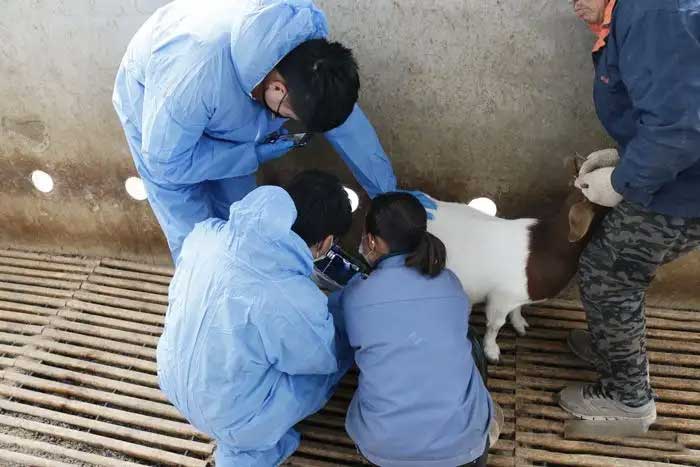1、Observation method
Ewes are not in heat for about 20 days after breeding, and there is no abnormal discharge from the pussy, combined with no history of uterine disease, you can initially determine pregnancy. As the pregnancy progresses, the feed intake of the ewe increases significantly, the speed of body fat increase accelerates, the abdominal circumference starts to increase significantly after 1.5-2 months, and the udder gradually fills up. At this stage, it is necessary to pay attention to the phenomenon of pseudo-estrus, and a few pregnant ewes will still show similar estrus behaviors such as tail wagging and chirping.
2、Ram test method
During the normal estrus cycle of ewes (about 17 days), introduce rams into the flock. Pregnant ewes will actively avoid the rams and refuse to accept climbing over them, and there is no tail-wagging, chirping and other courtship behaviors. The method needs to be implemented at least 20 days after breeding to avoid premature detection leading to misjudgment. For group farms, the test method can be used to quickly screen for non-pregnant ewes, and timely mating can improve the overall reproduction rate.
3、Observation of external signs
Pregnant ewes show three typical signs: shiny and smooth coat, slower but steady gait, strong appetite and longer feeding time. The temperament of the ewe is obviously docile, with less aggressive behavior and more inclined to be quiet and alone. After the second month of pregnancy, the abdomen shows unilateral bulging characteristics, experienced technicians can sense fetal activity through palpation, but need to pay attention to the strength of the operation to avoid triggering mechanical abortion.
4、Vaginal mucosa detection method
When using the sterilized lumen opener for inspection, the vaginal mucosa of pregnant ewes shows characteristic changes: pale pink when not conceived, turning to pale white after conception, and quickly returning to pink within 30 seconds after lumen opening. The method requires strict sterilization of instruments and the operation time is limited to 15 seconds to prevent triggering uterine infection. Unlike the white membrane caused by ordinary inflammation, the white membrane of pregnancy is even in texture and has no abnormal secretion attached.
5、Vaginal mucus analysis method
The vaginal mucus of pregnant ewes is transparent and gelatinous, with strong ductility, can be stretched to 8-10 centimeters without breaking, and after drying, it forms crystalline patterns. The mucus of non-pregnant ewes is grayish-white and thin, poorly stretchable and easy to break. This method should be performed 25-30 days after breeding, as early detection may lead to misdiagnosis due to incomplete transformation of the mucus characteristics.
Early detection of pregnancy with the help of a special ultrasound machine for sheep
Dawei’s veterinary ultrasound machine can accurately diagnose pregnancy at 30 days of gestation. Its 3.5MHz convex array probe clearly shows the location of the embryo’s bed, and can accurately determine the number of fetuses after 45 days of gestation. Compared with traditional methods, the misdiagnosis rate of ultrasound detection is less than 2%, and it can simultaneously diagnose uterine inflammation and other complications. It is recommended that after the initial screening of traditional methods, ultrasound review of suspected pregnant ewes be carried out to ensure the accuracy of detection and reduce the cost of equipment.
A three-stage diagnostic approach is recommended for breeding practice: initial screening by behavioral observation at 20 days after breeding, mucosal/mucus testing at 30 days, and confirmation of the diagnosis by sheep ultrasound at 45 days. This multi-method strategy can achieve 99.7% accuracy in pregnancy diagnosis, effectively avoiding the risk of missed detection of empty pregnancies and misjudgment of abortion.
Post time: Apr-10-2025




